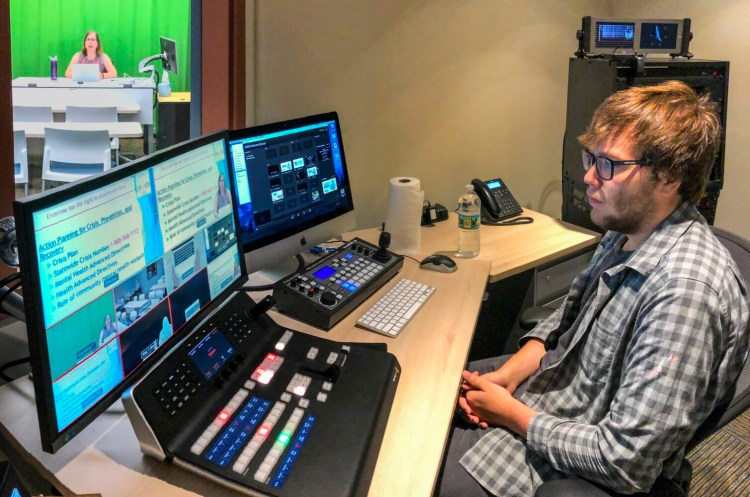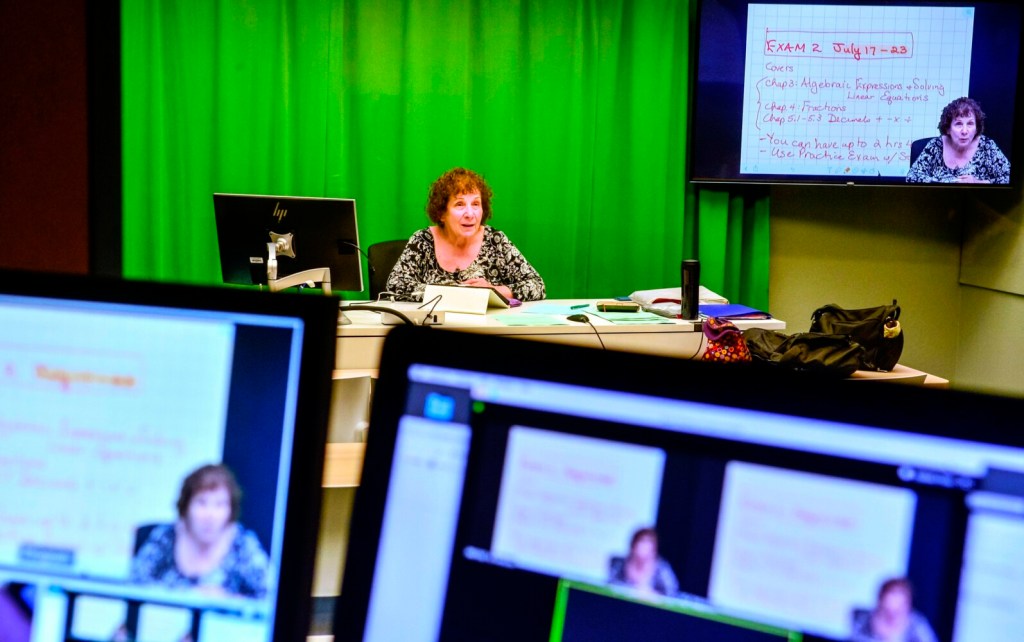“This isn’t like online banking,” said University of Maine Augusta student Emily Christiansen. “You’re a student teachers know.”
Through the UMA’s distance education program, Christiansen is remotely earning her bachelor’s degree in justice studies and her minor in behavioral sciences.
As a mother of five children aged 11 to 21 and with a full time position as supervisor of the transport division at the Kennebec County Sheriff’s Office, Christiansen takes classes when she can.
“If it were not for online, I would not do it all,” she said.
Christiansen takes classes late in the evening after she serves dinner and her three younger children, who live at home, go to bed. She takes them early in the morning before her day starts. She even takes them in her office at work when she’s off duty.
Christiansen’s goals are the same as any other student’s — to develop her skills and further her career — and the ability to take classes remotely means she can succeed in this.
This is the 30th year that UMA has been providing distance education.
The idea of distance education at UMA was pioneered by former president George Connick.
“What was created in 1989 was the first statewide comprehensive distance-learning network in the U.S.,” Connick said in a press release. “Educators came from all over the country to learn first-hand what we were doing.”
“There were a number of individuals seeking education,” said Domna Giatas, executive director of planning and communications. “We needed another way to bring classes to them rather than have them come to classes.”
In the beginning, students watched their classes on interactive television from UMA’s remote centers around the state. Now they can be anywhere in the world, and 46% of the university’s classwork is done online, Giatas said.
Associate Provost and Dean of the College of Professional Studies Brenda McAleer has been teaching remotely for 20 years.
“When I go into class, I have students in class with me, and the class is broadcasted,” said McAleer.
She said students watching the synchronous class can call a technician and speak to the class and ask or answer questions.
McAleer said students can “sit at home in bunny slippers,” and a link would “bring their computer into the classroom.”
But if a student is unable to view or attend classes live — even if the power goes out, if it is the middle of a winter storm or they are sick, McAleer said — they can watch pre-recorded class at their convenience.
“Students who watch at night sometimes have their families watch with them,” she said.
Director of Advanced Media and Instructional Design Justin Hafford said that the university is licensed to use the product Zoom, web conferencing software that allows professors and students to utilize screen sharing, video, audio and text for a fully immersive experience.
The distance education helps students who are geographically bound to still learn, and it helps both faculty members and students who are traveling.
“The product allows you to connect from wherever you have an internet connection on any device, including mobile,” Hafford said. “We picked it because it was easy to use.”
“I had trepidation about doing online classes before I got started,” said Christiansen. “I was pleasantly surprised about how user friendly it was, and the professors are super helpful.”
Hafford said that the technology started as “being very place specific and hardware intensive.
“Now very mobile and ubiquitous and software based.” He said it’s also cost effective because people can use equipment they likely already have, like their smartphone.
“The hardware in the classroom is disappearing, and it’s more seamless,” he said.
But that does not mean that the need for the classroom and the remote centers will go away, he said.
“Even though it is more convenient for different lifestyles, our humanity limits us,” he said. “Humans like community and having peers to study with and other services (like a library and technology). Those will still be critical to their success.”
McAleer said that the technology allows students who are introverted to be more successful.
“The students who would rather bite off their tongue in class than participate in discussion are the ones who craft responses beautifully behind the technology.”
The discussion board UMA uses is Blackboard.
“The interaction is so rich because everyone in the class is able to do it,” she said.
Though McAleer doesn’t get to see many of her students in person or even know what they look like, she said that it doesn’t stop the bonds she and her students form. She said she learns a lot about the individual students through essays.
As the dean of the College of Professional Studies, McAleer said she meets many of her students as she hands them their diploma at graduation.
“Now I can put a face with the name,” she said, “and we’ll hug on stage.”
The immediate future of technology of distance learning at UMA looks like access to more software, Hafford said.
Down the road, though, he anticipates augmented reality and virtual reality providing more interactive and immersive learning opportunities.
“Students will be able to study in 3-D,” he said. As an example where this would be useful would be in anatomy. “In the past we had to work with more physical materials in models and skeletons.”
Send questions/comments to the editors.





Success. Please wait for the page to reload. If the page does not reload within 5 seconds, please refresh the page.
Enter your email and password to access comments.
Hi, to comment on stories you must . This profile is in addition to your subscription and website login.
Already have a commenting profile? .
Invalid username/password.
Please check your email to confirm and complete your registration.
Only subscribers are eligible to post comments. Please subscribe or login first for digital access. Here’s why.
Use the form below to reset your password. When you've submitted your account email, we will send an email with a reset code.